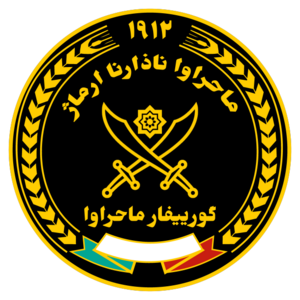Mehravan National Army
| Mehravan National Army | |
|---|---|
 | |
| Founded | 9 March 1912 |
| Current form | 1 February 2021 |
| Service branches | |
| Leadership | |
| Commander-in-Chief | Supreme Leader Arzhan Admejhad |
| Minister of Defence | Zaqând Razjhavan |
| Chief of Defence Staff | General Beghzôr Mâzandgi |
| Personnel | |
| Military age | 18 |
| Conscription | Yes |
| Available for military service | 21,707,694, age 15–49 |
| Fit for military service | 23,031,303, age 15–49 |
| Active personnel | 500,000 |
| Reserve personnel | 2,000,000 |
| Expenditure | |
| Budget | 37.6 billion $ACU |
| Percent of GDP | 4.1% |
| Industry | |
| Domestic suppliers |
|
| Foreign suppliers | |
The Mehravan National Army is the military forces of the State of Mehrava. They consist of the Mehravan Ground Forces, Mehravan Air Force and the Mehravan Navy. The President of Mehrava is the Commander-in-Chief of the Mehravan National Army, which is administratively controlled through the Ministry of Defense. The National Military Command Center in Azhtanan serves as the headquarters of the Mehravan National Army.
The current Mehravan military originates in 1902 when the Zârzakhid dynasty was established in Môztar followed by the Arzhanid dynasty. The Mehravan military fought many wars with foreign kingdoms from the 18th to the 19th century. It was re-organized with help from the Shadoveilian in 1912, when the country was ruled by Shah Zêrman Rôh Zârzakhi . It was modernized during Shah Zêrman's rule in the early 20th century, and upgraded during Shah Arâd's forty-year rule. After Shah Guzgân Arzhanid's resignation in 1985 and the end of monarchy, the military took control over the government. This era was followed by the rise of the Admejhad regime, who established a new government on the basis of military rule.
Budget
Mehrava's 2019 defense budget was estimated to be $ACU 37.600 billion, accounting for 4.1% of the national GDP.
Defense Industry
Under the last Shah of Mehrava, Guzgân Ajhad Arzhanid, Mehrava's military industry was limited to assembly of foreign weapons. In the assembly lines that were put up by foreign firms, Mehravan workers put together a variety of helicopters, aircraft, guided missiles, electronic components and tanks. In 1973 the Mehravan Electronics Industries (MEI) was established. The company was set up in a first attempt to organize the assembly and repair of foreign-delivered weapons. The Mehravan Defense Industries Organization was the first to succeed in taking a step into what could be called a military industry by reverse engineering the RPG-7, BM-21, and SAM-7 missiles in 1979.
Nevertheless, most of Mehrava's weapons before the revolution were imported from foreign countries. Between 1980 and 1984, the Shah went on a buying spree, ordering $ACU 8 billion in weapons alone. This alarmed the foreign countries's government, which strengthened a law on arms exports in 1984 and named it the Arms Export Control Act. Still, the foreign countries continued to sell large amounts of weapons to Mehrava until the 1985 Revolution.
After the revolution, Mehrava found itself severely isolated and lacking technological expertise. Because of economic sanctions and a weapons embargo put on Mehrava by the world council, it was forced to rely on its domestic arms industry for weapons and spare parts, since there were very few countries willing to do business with Mehrava.
The Armed Forces of the Militarized State of Mehrava were put in charge of creating what is today known as the Mehravan military industry. Under their command, Mehrava's military industry was enormously expanded, and with the Ministry of Defense pouring investment into the missile industry, Mehrava soon accumulated a vast arsenal of missiles.Since 1994, it has also produced its own tanks, armored personnel carriers, radar systems, guided missiles and fighter planes.